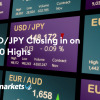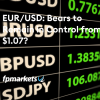EUR/USD:
Monthly timeframe:
(Technical change on this timeframe is often limited though serves as guidance to potential longer-term moves)
The euro nudged to a third successive monthly gain against the US dollar in July, adding nearly 5 percent. The move toppled long-term trendline resistance (1.6038) and made contact with the upper border of supply from 1.1857/1.1352.
This, alongside August also closing higher on the month, argues further moves to the upside may be on the horizon, with trendline resistance (prior support – 1.1641) on the radar as the next target. Also worth taking into consideration, though, is the primary downtrend (since July 2008) still remains intact, at least until 1.2555 is engulfed (Feb 1 high [2018]).
Daily timeframe:
Partially altered from previous analysis –
Efforts to extend higher in August were contained inside a rising channel pattern (1.1695/1.1909), in addition to supply at 1.2012/1.1937 making an entrance (August 18), extended from May 2018.
Trendline support (1.0774) currently intersects with the aforesaid channel support, potentially reinforcing the area in the event of a pullback/retest this week. On the other hand, immersing current supply favours moves to resistance at 1.2095.
Trend traders, however, will note that alongside the monthly trendline break, the immediate trend direction, based on the daily timeframe, has advanced since late March.
The RSI indicator, as you can see, is also seen approaching overbought space.
H4 timeframe:
As the US dollar index refreshed YTD lows on Monday, this elevated EUR/USD to fresh YTD peaks at 1.1966, moves that whipsawed through the upper boundary of supply at 1.1953/1.1929.
The decision point to break to fresh peaks, the demand at 1.1884/1.1908, may make its way into view today and likely cap downside attempts (although a whipsaw to demand at 1.1828/1.1868 [prior supply] could be seen).
With supply at 1.1953/1.1929 perhaps fragile, a reaction from demand at 1.1884/1.1908 could guide price to resistance at 1.1988.
H1 timeframe:
Heading into London on Monday, intraday activity retested 1.19 and latched onto a reasonably healthy bid. In Monday’s technical outlook, we stressed the possibility of further buying due to Friday surpassing not only the upper boundary of a pennant pattern between 1.1918/1.1868 but also 1.19.
Considered a continuation pattern, the bullish pennant take-profit target, measured by gauging the preceding move and adding the value to the breakout point (blue), can be found a few pips north of the widely watched 1.20 figure. 1.1950 resistance is proving troublesome for buyers, though the break to fresh YTD peaks has possibly cleared the majority of sellers (opposition) in this region.
Structures of Interest:
Aside from daily supply/channel resistance, the monthly, H4 and H1 reveal room to press for higher levels. Consequently, EUR/USD could indeed push for 1.20. Before reaching the said level, nonetheless, a retreat to H4 demand at 1.1884/1.1908 (houses 1.19 [on the H1] within) could be seen to entice dip-buyers for a move higher.
AUD/USD:
Monthly timeframe:
(Technical change on this timeframe is often limited though serves as guidance to potential longer-term moves)
May’s extension, together with June, July and August’s 3.3% follow-through, has witnessed supply at 0.7029/0.6664 and intersecting long-term trendline resistance (1.0582) abandon its position.
Technically, buyers now appear free to explore as far north as 0.8303/0.8082 in the coming months, a supply zone aligning closely with trendline resistance (prior support – 0.4776).
Although price has removed trendline resistance and a notable supply, the market’s primary trend (since mid-2011) remains south until breaking 0.8135 (January high [2018]).
Daily timeframe:
Partially altered from previous analysis –
By way of five successive daily bullish candles, AUD/USD closed out August crossing paths with supply at 0.7453/0.7384. The recent advance also established a drop-base-rally demand area at 0.7131/0.7192, and pulled the RSI indicator to within overbought territory.
The trend, according to the daily timeframe, has been higher since bottoming in late March.
H4 timeframe:
Monday’s ascent drew price action through supply at 0.7393/0.7366, unlocking prospective moves to another supply coming in from 0.7433/0.7414. Before advancing to higher levels, a dip to demand at 0.7339/0.7357 (a drop-base-drop formation), essentially the decision point to initially break higher, could be seen.
H1 timeframe:
From the H1 timeframe, nonetheless, we are able to see price reacting from 0.74 resistance, poised to grapple with demand at 0.7357/0.7368, an important area given it was here a decision was made to form fresh YTD peaks. Although the demand area could control downside pressure, a whipsaw to 0.7350 support is certainly not out of the question before buyers make a stand.
Structures of Interest:
Monthly action suggests higher moves after taking supply at 0.7029/0.6664, though the primary trend is still down. Daily price recently connected with supply at 0.7453/0.7384. H4, however, took out the top edge of supply at 0.7393/0.7366, perhaps unlocking upside to supply at 0.7433/0.7414 (sheltered within daily supply). And as for H1, we’re coming from 0.74 resistance, heading for demand at 0.7357/0.7368.
Given the above, H1 demand at 0.7357/0.7368 may greet price today and provide fuel to lift higher, though be aware a whipsaw into H4 demand at 0.7339/0.7357 is possible as the former sits on top of the H4 area.
USD/JPY:
Monthly timeframe:
(Technical change on this timeframe is often limited though serves as guidance to potential longer-term moves)
Since kicking off 2017, USD/JPY has been carving out a descending triangle pattern between 118.66/104.62. July sunk nearly 2 percent, testing the lower boundary of the descending triangle, while August ended off best levels, effectively unmoved.
Areas outside of the noted triangle can be seen at supply from 126.10/122.66 and demand coming in at 96.41/100.81.
Daily timeframe:
Partially altered from previous analysis –
Supply from 107.58/106.85 has proved a tough nut to crack (an area sharing space with trendline resistance from 111.71 and also located just under the 200-day simple moving average at 107.93) in August.
Despite Monday’s recent advance, trading to the downside, a move that takes on 104.62, shifts interest to demand at 100.68/101.85, drawn from 2016.
H4 timeframe:
Following Friday’s completion of a three-drive bearish formation at the 127.2% Fib ext. level from 106.86, H4 candles greeted demand at 105.06/105.30 (prior supply). Monday recovered in strong form to end the day testing a trendline resistance (prior support 105.10).
H1 timeframe:
US trading gathered traction Monday and surged through buy-stops above the round number 106, consequently testing the 100-period simple moving average. We have since reclaimed position sub 106 and, technically speaking, are poised to approach an area of demand from 105.55/105.73, with particular interest in 105.66. Note if we test the aforesaid demand from current price this will also produce a minor ABCD approach.
Structures of Interest:
Intraday we’re coming off H4 trendline resistance, perhaps providing enough fuel to test H1 demand at 105.55/105.73 to bring things higher. Technically, this is in conjunction with the monthly timeframe bouncing/holding off support at 104.62.
GBP/USD:
Monthly timeframe:
(Technical change on this timeframe is often limited though serves as guidance to potential longer-term moves)
GBP/USD finished higher by 2.2 percent in August, leading to an extension north of a recently penetrated long-term trendline resistance (1.7191).
Despite the primary trend facing lower since early 2008 (unbroken until 1.4376 gives way – April 2 high [2018]), the break of current trendline resistance has September likely targeting trendline resistance (2.1161).
Daily timeframe:
Buyers eventually mustered enough strength to overtake resistance at 1.3201 last week, with Monday extending upside and topping a few pips ahead of a 161.8% Fib ext. level at 1.3408.
1.3021/1.2844 remains stationed as demand, should 1.3201 support give way.
The 200-day simple moving average at 1.2729 is seen mildly turning higher after flattening in early April. Also notable is the current trend facing north since March and the RSI indicator recently engaging overbought levels.
H4 timeframe:
As can be seen from the H4 chart, the pair dipped to demand at 1.3301/1.3273 (a prior supply drawn from December 2019) on Monday, and produced a vigorous H4 bullish candle to supply from 1.3422/1.3389, an area housing a 161.8% Fib ext. level at 1.3421.
H1 timeframe:
Demand at 1.3309/1.3337, a particularly important area as it was somewhere within this zone a decision was made to not only pursue fresh YTD peaks, but also run through orders at 1.3350 resistance, is in sight. As we have yet to meet 1.34, a push through 1.3350 to collect unfilled buy orders at 1.3309/1.3337 could be in store today.
Structures of Interest:
Longer-term price movement signals buyers remain in the driving seat, at least until we engage the 161.8% Fib ext. level on the daily timeframe at 1.3408.
H4 trades from supply at 1.3422/1.3389 (encases the daily 161.8% Fib ext. level), a move that may contain enough fuel to reach H1 demand 1.3309/1.3337, which, for many traders, is likely to represent a bullish reversal zone (though do remember to factor in the possibility of a whipsaw into 1.33 support).
DISCLAIMER:
The information contained in this material is intended for general advice only. It does not take into account your investment objectives, financial situation or particular needs. FP Markets has made every effort to ensure the accuracy of the information as at the date of publication. FP Markets does not give any warranty or representation as to the material. Examples included in this material are for illustrative purposes only. To the extent permitted by law, FP Markets and its employees shall not be liable for any loss or damage arising in any way (including by way of negligence) from or in connection with any information provided in or omitted from this material. Features of the FP Markets products including applicable fees and charges are outlined in the Product Disclosure Statements available from FP Markets website, www.fpmarkets.com and should be considered before deciding to deal in those products. Derivatives can be risky; losses can exceed your initial payment. FP Markets recommends that you seek independent advice. First Prudential Markets Pty Ltd trading as FP Markets ABN 16 112 600 281, Australian Financial Services License Number 286354.












 Access +10,000 financial
instruments
Access +10,000 financial
instruments

